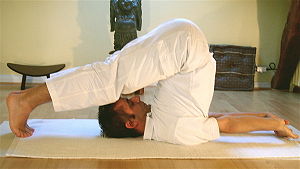 |
| Yoga postures halasana (Photo credit: Wikipedia) |
The classical techniques of Yoga date back more than 5,000 years. In ancient times, the desire for greater personal freedom, health and long life, and heightened self-understanding gave birth to this system of physical and mental exercise which has since spread throughout the world. The word Yoga means “to join or yoke together,” and it brings the body and mind together into one harmonious experience.
The whole system of Yoga is built on three main structures: exercise, breathing, and meditation. The exercises of Yoga are designed to put pressure on the glandular systems of the body, thereby increasing its efficiency and total health. The body is looked upon as the primary instrument that enables us to work and evolve in the world, and so a Yoga student treats it with great care and respect. Breathing techniques are based on the concept that breath is the source of life in the body. The Yoga student gently increases breath control to improve the health and function of both body and mind. These two systems of exercise and breathing then prepare the body and mind for meditation, and the student finds an easy approach to a quiet mind that allows silence and healing from everyday stress. Regular daily practice of all three parts of this structure of Yoga produce a clear, bright mind and a strong, capable body.
Yoga Poses
Take a peek into a yoga class at your gym or local yoga studio and you will see students moving through postures as if choreographed. The teacher gives the name of the pose and the students assume the position in unison. If you have never done yoga, this may seem mysterious, but once you get started, you soon learn the poses associated with names like Downward Facing Dog and Happy Baby.
At the beginners’ level, the study of yoga is devoted to learning how to do basic poses correctly. Beginning poses are yoga's building blocks; you will return to them again and again. At the intermediate level, these basic poses are further refined and more difficult variations are introduced as the body becomes stronger and more flexible. Advanced poses require great strength and flexibility, usually achieved through years of practice. Although classifying poses by level of difficulty makes yoga seem goal-oriented, quite the opposite is true. You have a lifetime to explore and develop your yoga practice. Learning to work at your own level and listen to your body is one of yoga’s greatest lessons.
Beginner
Beginners' poses start to establish basic strength and flexibility throughout the whole body. These include standing poses, seated and supine stretches, and introductory backbends and balancing poses. Though it takes time to master these poses, eventually you want will to expand your repertoire. It's a yoga adage that if you can put together your grocery list in your head while in a particular pose, it's probably time to try something more challenging.
Downward Facing Dog - Adho Mukha Svanasana


Downward Facing Dog Split
Extended Side Angle Pose - Utthita Parsvakonasana

Garland Pose - Malasana
Forward Fold

Mountain Pose - Tadasana


Lunge Pose
Pyramid Pose - Parsvottonasana
Raised Hands Pose - Urdhva Hastasana
Standing Forward Bend - Uttanasana
Standing Straddle Forward Bend - Prasarita Padottanasana
Triangle Pose - Trikonasana

Warrior I - Virabhadrasana I

Warrior II - Virabhadrasana II

Intermediate
Intermediate poses will require greater strength, flexibility, and balance. There is a wide range of intermediate poses, so don't be surprised if you find some easy and others impossible at first. At the intermediate level, you will be ready to add some arm balances and inversions to your practice, as well as increase the difficulty of your standing poses and backbends.
Standing Poses
Chair Pose - Utkatasana

Eagle Pose - Garudasana
Extended Side Angle Variations - Parsvakonasana
Half Moon Pose - Ardha Chandrasana


King Dancer Pose - Natarajasana
Lizard Pose - Utthan Pristhasana
Monkey Pose

Pyramid Pose Variations - Parsvottonasana Variations
Reverse Warrior Pose

Revolved Side Angle Pose
Revolved Triangle Pose
Sugarcane Pose - Ardha Chandra Chapasana
Tree Pose

Warrior III - Virabhadrasana III

Seated Poses
Cow Face Pose - Gomukhasana
Boat Pose - Navasana

Hero Pose - Virasana
Knee to Ankle Pose
Lotus Pose - Padmasana
Pigeon Pose - Eka Pada Rajakapotasana Prep

Backbends
Bow Pose - Dhanurasana
Camel Pose - Ustrasana
Fish Pose - Matsyasana
Locust Pose - Shalabasana
Upward Facing Dog/Cobra - Urdhva Mukha Svanasana


Arm Balances
Four Limbed Staff Pose - Chaturanga Dandasana
Crow Pose - Bakasana
Scale Pose - Tolasana
Side Plank Pose - Vasisthasana
Sleeping Vishnu Pose - Anantasana
Inversions
Headstand Pose - Salamba Sirsasana
Plow Pose - Halasana
Shoulderstand - Salamba Sarvangasana
Advanced
Advanced poses continue to expand the limits of the body through deep backbends and intense arm balances and inversions. When you feel comfortable attempting these poses will vary greatly, though it is neither unusual nor inappropriate for them to be introduced in intermediate level classes.
Standing Poses
Bird of Paradise
Revolved Half Moon Pose - Parivrtta Ardha Chandrasana
Backbends
Little Thunderbolt Pose - Laghu Vajrasana
One Legged King Pigeon Pose - Eka Pada Rajakapotasana
Wheel Pose - Urdhva Dhanurasana
Seated Poses
Compass Pose - Parivrtta Surya Yantrasana
Arm Balances
Dragonfly Pose
Firefly Pose - Tittibhasana
Flying Crow Pose - Eka Pada Galavasana
Side Crow Pose - Parsva Bakasana
Inversions
Forearm Stand - Pincha Mayurasana
Handstand - Adho Mukha Vrksasana
Scorpion Pose - Vschikasana
Sources
http://yoga.about.com/od/yogaposes/a/posesindex.htm
http://joypeaceandhealth.com/category/pose-guide/

No comments:
Post a Comment